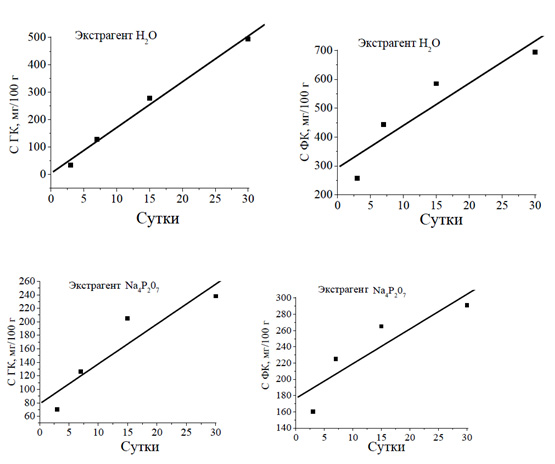Humus formation as a process of plant residues transformation
DOI:
https://doi.org/10.31251/pos.v8i1.307Keywords:
humus; humic acids; fulvic acids; sod-podzolic soil; quartz sand; plant residues; humus formation.Abstract
The study aims to confirm the specificity of humic acids extracted from various substrates with different extractants, by applying mathematical models.
Methods. The article analyses some classical methods used for isolating humic acids during the plant residues transformation; the methods were assessed by mathematical modeling. Such interdisciplinary approach, i.e. combining soil organic matter biochemistry and mathematical modeling, helped establishing an evidence base for humus specificity. Using up-to-date OriginPro software for data analysis and high-quality visualization, the study analyzes earlier published results of the experiments investigating the decomposition of plant residues as primary humus precursors. Model experiments examining the humification of plant residues (clover leaf biomass) were conducted under controlled conditions in sod-podzolic light loamy soil and quartz sand. Humic substances were extracted using distilled water and 0.1 M sodium pyrophosphate solution. Humus carbon content was determined by the wet combustion method with titrimetric determination.
Results. The study provided experimental evidence of humic substances specificity, based on the differences in their extraction from soils by various extractants, and modeled mathematically. The nature of humus is discussed from the perspectives of soil biochemistry and mathematical modeling of plant residue transformation into specific humic compounds. It was shown that, in both soil and inert media, the early-stage dynamics of humic compound formation was well approximated by a simple linear trend. Moreover, the accumulation rates of humic and fulvic acids were nearly identical across environments. As the mass of the organic substrate decreased, the transformation process transitioned to a saturation phase.
Conclusions. Experimental data revealed that the amount of humic acids formed during plant residues transformation depended on the mineralogical and chemical composition of the medium. It was demonstrated that using different extractants to extract humic substances from soil and inert media (quartz sand) not only supported the notion of the existence of specific humic compounds, but also highlights the distinct formation pathways of their individual groups. Notably, there was revealed a shared feature across environments, i.e. that the humic compounds formation during organic matter transformation was well approximated by a simple linear model. It was found that at early transformation stages the rates of increase in humic and fulvic acid content were almost identical in both soil and inert media.
Downloads

Downloads
Published
How to Cite
Issue
Section
License
Copyright (c) 2025 The Journal of Soils and Environment

This work is licensed under a Creative Commons Attribution 4.0 International License.






